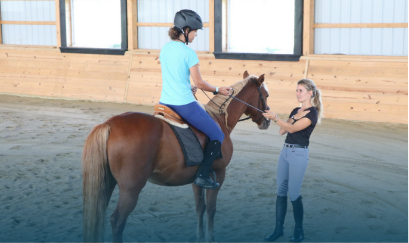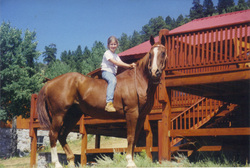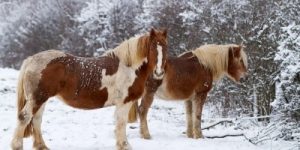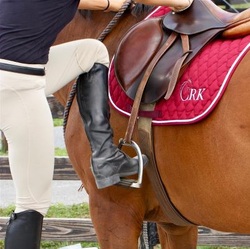What are you really good at in your riding? What’s one of your strongest skills?
If you hesitated and struggled to think of a response, then you are with the majority of riders I work with.
But you are also affecting your potential as a rider and making the process of learning and improving more difficult.
Why? With a positive focus we learn faster, we retain information, and we make progress.
This isn’t meant to just be a motivational pep talk. I’m going to do more than encourage you to “stay positive and keep trying”. While that’s not bad advice, it’s rather trite, and the truth is it’s hard to always have a happy outlook when we run into persistent challenges.
Implementing positive learning is different than being cheery and happy and saying “well, there’s always tomorrow!”. Again, while it’s a good mindset to have, there are more specific strategies you can use that are backed by research and will impact how effectively and quickly you learn.
We are going to look at three.
- Acknowledge what you are good at and celebrate your success.
- See humor in mistakes.
- Change old patterns or habits using novelty, curiosity, and experimentation.
Riding lessons and clinics are often taught in a way that unfortunately, does not implement these strategies for good learning.
Instructors focus on telling students what they are doing wrong, often without providing a clear path about how to improve it.
Let’s begin with the first of these three strategies.
Acknowledge what you are good at and celebrate your success.
When someone compliments you – an instructor or a riding friend says “wow, your hands look so steady” or when you achieve success in something, for example you just maintained a rising trot around a perfectly shaped 20 meter circle, acknowledge it!
Smile, and allow yourself the pride of a task well done.
Notice if your reflex is to respond with a negative comment or thought such as “yeah but I’m still so terrible at trying to sit the trot….”. When you notice this pattern of deflecting a compliment or acknowledgement of success, interrupt it and allow yourself a moment to feel good about your accomplishment.
The next step is to continue to picture what you want to do, instead of picturing your problem. You can start to develop a clearer mental picture by noticing your own self talk.
For example, if your canter transitions tend to get a bit unorganized, don’t think “I have got to quit bouncing around and throwing my legs forward at the canter!”
Instead, talk yourself into a better mental picture as you imagine sitting balanced and poised as you ask for canter, your leg under you, sitting tall, and allowing your horse to lift lightly into canter.
To take this a step further, look to develop your visualizations from a first-person perspective. There has been evidence that first person visualization (imagining the scene out of your own eyes) engages more areas of the brain than visualizing from an external perspective.
If working with an instructor, you may need to translate what they tell you into a positive image. For example, if they say, “stop throwing your upper body forward for canter”, translate that into “sit still, allow my horse to lift into canter” or “keep my shoulders over my hips”, whatever phrase and mental imagery makes sense to you.
The next step is to see the humor in your mistakes.
The process of learning is full of mistakes. The freer you are to try different things, the more quickly you can sort out what works and what doesn’t.
[Tweet “The process of learning is full of mistakes. The freer you are to try different things, the more quickly you can sort out what works and what doesn’t.”]
As the famous quote from Einstein states, “the definition of insanity is doing the same thing over and over expecting a different result.” But that is what happens to so many of us in our riding. We try to stick to the same old riding advice – keep my heels down, keep my hands at the wither, keep my shoulders back – without ever stopping to question those instructions or even to accomplish them in a different way.
We believe that we just need to try harder – get my heels lower, get my core tighter, lunge my horse longer – but trying harder can simply get us more stuck in the pattern that wasn’t working.
To find change, we need to do something different. Patterns are most easily broken through experimentation, novelty, and fun.
Sometimes you need the information a different way – pick up a book, watch a video, join a course.
Other times you need to do something different – try an interesting riding exercise, experiment in other disciplines, change your position and see how it feels.
Have fun with the learning process and don’t fear mistakes. The trajectory of learning and improvement is rarely linear – it has ups and downs, two steps forward and one step back, but when you adapt a mindset that there can always be a new way, the solution will come.














30 Responses
Callie,
This is an inspirational video. I have had to think hard about what I’m good at as I am so over focused on what I’m trying to “change!” I would say that my feel for the horses mouth through the reins has improved enormously and my ability to sit so that I can feel and use my seat bones (seat) for following movement better (especially in the walk) and initiate turns from my seat with minimal use of the reins. I will now try to tackle my other issues with a little more flexibility of different ways of thinking more pro-actively positive spin with more freedom to experiment.
I agree, especially with the first sentence and with the seat bones and following movement, reduction of use of reins. I’m increasingly trialling seat first (core muscles etc)
I like the experimental stuff, this morning I was trialling my shoulder back, hand lifted on convex side, just to see whether I could feel a difference in her movement. (down a narrow path). Of course, I wondered if that would confuse herself! And that could be a problem?
Hi Callie,
Love this video – so very true that as riders as we strive for better, we can become so critical of ourselves (sadly, with our beloved horse also) – at times it’s so very hard to find the positive. So to answer your question I’m pleased with my new found awareness for calm connection in my riding. At times it doesn’t last for more than a new strides, but now I see it and feel it and can go back happily to finding it again, the saying that less is more, has much more meaning. Thank you for your posts.
I love that saying too! “less is more”
oops – meant ‘few’ strides, not new LOL
Hi Callie!
I am so glad I found your website! I enjoy your videos so much, they are very helpful!
It’s really hard for people to accept compliments, even in their own mind. For some reason you feel that you will seem conceited if you say or think you are good at something. Your positive advice is very constructive.
I started riding pretty late in my life, with a young horse. Oops! I’ve been riding for almost 4 years now and am starting to feel like my balance and confidence has improved so much. I still get a little apprehensive, especially going into frisky weather season, but with lots of support from my trainer, I feel that I’m more able to direct his energy in a positive way. It’s so empowering to feel like I can take charge of my little freight train!!
Thank you for your help! I wish we lived in the same area. I’d love to take lessons with you in person! Meanwhile I will enjoy your
videos!
Hi Cathy, glad you are enjoying the videos, and welcome!
I am getting better at keeping my seat when my horse tries to spin and bolt…and that makes me feel more confident!
I am good at having soft hands. Wish I was better at riding the trot. . I bounce so much.
But thinking positive give hope to be better and appreciate how far I’ve come.
My instructor often tells me how I keep my legs in the proper position throughout transitions and cantering. I am more than happy to laugh at my mistakes, but I do tend to over-analyze them too. Thanks for this video – they always seem to come at the perfect time for me!
I’m good at being able to monitor where my horses are emotionally while riding. I can approach thresholds without going over the threshold. I’m just watching my mind now as it wants to reflex into all the shortcomings of my riding. Super interesting. Thanks Callie.
Callie,
I am good at crossing the diagonal at the walk or trot. I enjoy the feel of the longer stretched down walk; and the energy of changing posting diagonal while maintaining the trot across the arena. Wow, that is a clear mental picture for me as I write it. Whenever my instructor cues me to “half halt” I have to say, I can begin to feel that rein energy in my hands. (even when it slips away) 🙂
Nice observations Judy 🙂
Thank you for an excellent training video. Utah and I are beginning to be good at a relaxed trot in the arena. I appreciated the reminder to thank my instructor when she tells me I’ve done something well. My instructor is very positive and will always find something I am doing well. In addition, she always makes Utah and me end our lesson on a positive note.
Thanks for doing this great video. I recently received a compliment from a trainer that took me by surprise and my immediate reaction was …”Oh I obviously need more practice”. I’m afraid I am one of those self critical people you mentioned! While I don’t feel that I’m great at anything, I do think I’m getting better at many things all at once, both on a technical and mental/emotional level. My confidence has increased dramatically from learning from my mistakes, researching what I could have done differently (including taking your courses and watching your terrific videos), trying out new ideas, and just persevering. It’s really exciting to see that improvements in my riding have also had a positive impact on the well-being and performance of my horse.
Nice work Margaret 🙂
I have a general question
I am a new horse ridding learner
I can ride by my self … not in a launge
My mare always stritch her nick and head and pulls the reins … she also stear her nick down while trotting and i think that may also make me fall down …. besides that if i held the reins she can pull my back down forward … i don’t want to let her get the reins to be able to control her
What is that
And way that is happening
And how can i solve the problem
Thanks
Hi Mohamed, thanks for your question. Unfortunantly questions like this are almost impossible for me to answer accurately without more information or seeing what is going on. My first guess is that if this is a school horse this may just be her habit. Your position is the key to not getting pulled forward when she does this. Watch the second video in this series for a tutorial on one way to “test” your position. https://crktrainingblog.com/7days
I have good leg osition and I’m able to maintain it during trot. We are all really good at negative self talk and often do not treat ourselves very kindly. I love this video because it turns this right around. Thank you
I stay calm even when the horse is spooky. I feel very comfortable around them but am very careful to stay vigilant with safety and the possibility for accidents on the ground and in the saddle.
Great video to keep motivated!
I am good at having a laugh at myself, though sometimes after all is said and done.
As an adult amateur it can get frustrating in the moment, but I always end up laughing.
This video is very timely for me. I am a relatively new rider, and I will be taking a lesson from a new instructor tomorrow. My self-talk is often pretty negative, and you have prompted me to think about how I would answer if my new instructor asked me: what do you do well? I guess my answer would be that I have pretty good balance. I am comfortable riding bareback at the trot, riding with no reins, riding with my eyes closed. As you mentioned in the video, however, I still want to finish that sentence with….but I am terrible at….
I am excited….and a bit apprehensive….to ride a different horse and get instruction from a different perspective. I very much needed the reminder to keep my sense of humor! Thank you, Callie.
Hi Sue, I hope your lesson goes well tomorrow! Thank you for your comment!
This is a timely video! I actually thought, “I should incorporate these points in dealing with the new horse!” before you said it. I’m considering leading a more advanced horse that is very stubborn and very evasive of hand-mouth contact. I’m told that with time and a lot of battles she eventually will accept contact, but it occurred to me that we need to forget the mouth for a while and concentrate on listening to my vocal cues (auto spell: curses lol) and my seat, so I’ll suggest to my trainer that we change things up with lunge work and esp over trotting poles to get her to look down and relax her neck (also: improve my seat!)
Yes! These are great ideas! I love tackling problems in a more round about way instead of trying to battle them head on!
I am good with ground work as well as laughing at my mistakes whenin the saddle..
I finally got a chance to watch this last video. Thank you for addressing so many techniques to help us learn. During my last lesson I was controlling turning my horse particularly well which was initially just learning the posting trot…. and I did tell commend myself. Now I am trying to focus on controlling speed (not squeezing too much) but also when my (lesson) horse starts dragging how to get him to pick up the pace. When he’s being pokey – my instructor tells me to “push him forward” though I am not quite sure how to do that. Is it a brief light squeeze from both my heels, a little longer with the heel pressure or squeeze full on leg contact? I also find it hard to not lose the rhythm of the post in doing that? Can you offer any advice?
Hi Karen, great question – where you will feel it in your legs depends on how you and your horse fit together. For example if you are a tall rider on a little pony you will likely only feel contact in the top of your calves. On the other hand, if you’re a short rider on a full barreled horse you will feel more along the length of your calf and ankle. To keep the rhythm of your posting, try doing less of a squeeze at first. This will make it easier for you not to over-tense, although you may need to back up your request for more forward motion with a tap from a whip to get the response from your horse.
Hi Callie. I have found my balance has improved while doing bareback yoga. I created this to alleive tension in fellow riders and found the made up moves created fun n structured balance positions for all who join in. It’s been fun and all look forward to it to stretch before the trails.
The one thing I am good at is recognizing a brilliant teacher when I see one. Your whole approach and content and awareness of what is needed is rare. You are going places and I couldn’t recommend you work more highly. You are a gift to the horse world keep it up